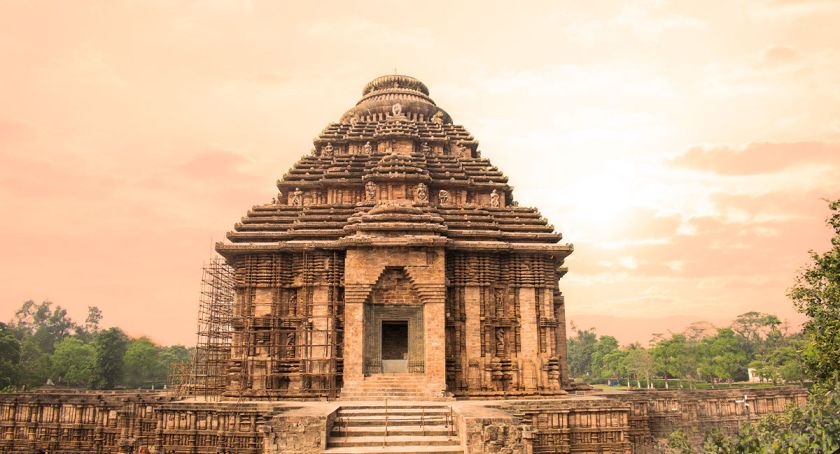Magnificent Glory of Konark Sun Temple
In the heart of Odisha, standing majestically against the backdrop of the Bay of Bengal, lies the Konark Sun Temple—a magnificent ode to India’s rich architectural heritage and devotion to celestial deities. This UNESCO World Heritage Site, often called the Black Pagoda, is not just a stone structure but a living narrative of artistry, mythology, and history. Let’s set out on a historical voyage to learn about the magnificence of this architectural wonder.
History: Konark Sun Temple
King Narasimhadeva I constructed the Konark Sun Temple in 1250 AD. The architects designed it as a colossal chariot for the Sun God, featuring 12 intricately carved wheels and seven mighty stone horses, symbolizing his celestial journey across the sky. According to historical records, the temple took approximately 12 years to build and required the dedicated labor of 1,200 skilled artisans.
Unfortunately, the temple’s magnificence was not immune to the ravages of time. Over centuries, invasions, natural calamities, and neglect led to its partial ruin. However, the remnants still stand tall, offering a look into the architectural brilliance of the past. Legends narrate that the temple once housed a floating idol of Surya, held in place by a complex magnetic mechanism. Whether fact or myth, these stories add to the mystical allure of Konark, making it an important historical and spiritual landmark.
Architectural Wonder
Among the most striking features of the Konark Sun Temple is its chariot-like design, an embodiment of divine artistry and astronomical precision. The temple’s architecture reflects not just religious devotion but also scientific ingenuity. Some of its most fascinating highlights include:
- The Giant Wheels: The temple has 12 complex carved wheels, which function as sundials and mark the passage of time with remarkable accuracy. Each wheel represents a month of the year, illustrating the profound understanding of astronomy possessed by ancient Indian architects.
- The Seven Horses: Seven galloping horses portray the temple as drawing a chariot, symbolizing the days of the week and the relentless movement of time.
- The Main Sanctum (Deul): Although now partially destroyed, the sanctum once enshrined the deity of the Sun God. The walls surrounding this sanctum display complex carvings narrating stories from Hindu mythology.
- The Natya Mandapa (Dance Hall): Temple dancers, known as Devadasis, used to perform sacred dances in adoration of Surya on the exquisitely carved Natya Mandapa (Dance Hall). The beauty of the carvings shows the creative sophistication of the time.
Enthralling Carvings & Sculptures
Thousands of beautiful carvings adorn the temple’s walls, each narrating a unique story. These sculptures provide a deep insight into medieval Indian society, religion, and culture. Some of the most notable features include:
- Erotic Sculptures: Reminiscent of the famed Khajuraho temples, Konark also houses complex carvings depicting aspects of human relationships, spiritual enlightenment, and the cosmic connection between human desires and divine fulfillment.
- Celestial Figures: Graceful depictions of dancers, musicians, and divine beings add to the temple’s artistic charm, showcasing the deep-rooted connection between art and spirituality.
- Scenes from Daily Life: The carvings beautifully illustrate traders, warriors, hunters, and ordinary folk, offering a rare look into the social and economic life of medieval India.
Myths and Legends That Inspire
The Konark Sun Temple is shrouded in fascinating myths that enhance its mystical aura. One of the most enduring legends is the tale of a young prodigy named Dharmapada. According to folklore, the chief architect and his workers faced an unsolvable architectural flaw during the temple construction.
A 12-year-old boy named Dharmapada, son of the chief architect arrived at the site and miraculously devised a solution overnight. Despite his genius, he realized his success might overshadow the artisans and their years of effort. To prevent any dishonor to his father and the workers, Dharmapada is said to have sacrificed his life by jumping into the nearby Chandrabhaga River. His tale remains a symbol of dedication, wisdom, and selflessness, forever linked to the legend of Konark.
Adventuring Konark Sun Temple
A visit to Konark is a captivating experience, offering much more than just historical insights. Some of the must-explore attractions include:
- Light and Sound Show: This evening spectacle narrates the temple’s history through captivating light and sound effects.
- Archaeological Museum: This museum houses artifacts and sculptures recovered from the temple site and provides deeper insights into its architectural and historical significance.
- Nearby Attractions: Chandrabhaga Beach, Ramachandi Temple, and the scenic coastal roads of Odisha offer visitors a perfect blend of spirituality and natural beauty.
A Tale Carved in Time
The Konark Sun Temple is more than just an architectural masterpiece—it symbolizes devotion, artistic brilliance, and historical grandeur. Its chariot-like design, complex carvings, and spiritual significance make it one of India’s most treasured monuments. Konark offers an experience that one will never forget, whether exploring its rich history, appreciating its inventive architecture, or finding peace of mind. The temple evokes astonishment and admiration as a tribute to India’s illustrious past, ensuring its status as a timeless wonder for decades.


